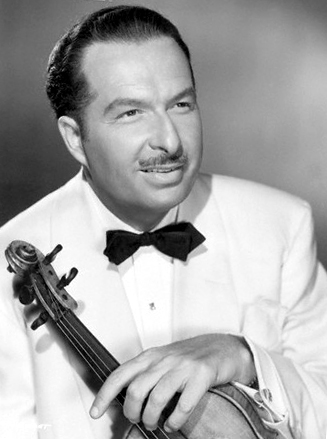
According to music critic John S. Wilson, "When sound motion pictures were first made,
he [ Cugat ] spent $35,000 in 1928 to produce one in Spanish. He did not find out until he had completed the film that there were not yet any sound projectors in Latin America."
vital stats:
given name Francisco de Asis Javier Cugat Mingall de Bru y Deulofeo
birth Jan.1, 1900, Girona, Spain
death Oct. 27, 1990, Barcelona, Spain, "heart failure because of arterial sclerosis"
parents Juan and Mingall (de Bru) Cugat
brother Francis, a portrait painter
brother Enric
first wife Rita Montaner, b. in Cuba
second wife Carmen Castillo, b. in Mexico, m.Oct. 17, 1929, div.1944
third wife Lorraine Allen, b. in Chicago, IL, m.1947, div.1952
fourth wife Abbe Lane, singer - "bombshell," b. in Brooklyn, NY Dec. 14, 1932, m.1952,
div.1966
fifth wife Charo Baeza (i.e, "Charo), a singer - actress, b. in Spain Jan. 15, 1951, m.1966,
div.1978
awards Orden de Honor y Merito de la Cruz Roja Cubana, con el Grado de Comendador
("Order of Honor and Merit of the Cuban Red Cross, with the Rank of Commander"),
1941
residence Waldorf Towers, New York City (1940s)
Cugat's early six-piece group worked as a relief band at the Cocoanut Grove of the Ambassador Hotel in Los Angeles. They made a short film, "Cugat and His Gigolos" (the title referred to eight male Latin-Americans who, with their dancing partners, demonstrated the tango).
In 1933, the musicians moved to New York City to open at the new Starlight Room of the Waldorf-Astoria Hotel, where they were paid $500 a week. Compare that to 1949, when Cugat's group had grown into an orchestra which had become the star attraction at the Hotel, earning $7,000 a week plus a percentage of the cover charges.
Entertainers who first became prominent while with Cugat included, at various times, his vocalists Lina Romay and Miguelito Valdes, and Desi Arnaz, who also sang and played guitar with Cugat's band in 1936-37.
Besides typically working the Waldorf-Astoria through the summer and into the fall, Cugat and his orchestra made tours to other cities, playing theatre, hotel, and college dates.
Cugat was also seen in quite a number of motion pictures, including a 1936 Mae West film, "Go West, Young Man." During the 1940s, he made more than a dozen motion picture appearances, such as in "You Were Never Lovelier" with Rita Hayworth and "Bathing Beauty" with Esther Williams.
Later he frequently appeared on television, guesting on "The Ed Sullivan Show" 16 ( ! ) times between 1954 and 1967, among a long list of other programs.
Cugat's recording career began in 1933 on Victor, and included such selections as his theme, My Shawl (Ombo); The Lady in Red; Jalousie; Cielito Lindo; La Paloma; One-Two-Three Kick; Siboney; and La Cumparsita. Dinah Shore sang four titles with Cubat's band in May and June of 1940: When the Swallows Come Back to Capistrano; The Breeze and I; The Rumba-Cardi; and Whatever Happened to You?.
In October 1940, Cugat's band switched to Columbia, where they recorded Orchids in the Moonlight; Tico Tico; and Walter Winchell Rhumba. Frank Sinatra made a pair of sides with Cugat for the label in May 1945, and singer Buddy Clark did one of Cugat's own compositions, Chiquita Banana, with the band in June 1946.
Cugat and his orchestra briefly switched to Mercury Records in 1952, had contracts of varying length with RCA Victor, Columbia, and Epic, before returning to Mercury in September 1960 for five years, and then signing with Decca until 1968.
Though Cugat suffered a stroke in 1969 and became partially paralyzed, he recovered and conducted an LP of new versions of his old hits for Victor Musical Industries of Japan in 1971.
Xavier Cugat - In His Own Words:
"I learned very early that everyone in the United States specialized in something . . . so I decided to
specialize in tropical music - we called it the rumba abierta then. Today they call it salsa, but it's all
basically the same thing."
"I like women-all women.... Also, there is my temperament. I am Latin. I excite. For me, this is life."
"I cannot go for old people . . . I have to be with young people. Old people talk to you about hospitals
and medicine and make you feel old."
"I have experienced life in every way that a man can. I know about being hungry and about living well.
I have traveled the world and loved and been loved."
Despite Cugat's advancing age and more serious health problems, including four heart attacks, he still maintained an eye for the ladies.
At 77, he became attracted to a beautiful 20-year-old girl and their romance lasted past his mid-80s.
Cugat kept some business interests going, too.
In the late 1970s, he lent his name to an eatery, Casa Cugat, on N. La Cienega Blvd. in West Hollywood, CA (just up the street from the Lobster Barrel, operated by Alan Hale, who had played "The Skipper" on the "Gilligan's Island" TV show).
He even unveiled a new, 16-piece band in Barcelona in 1987, hoping to "get back in the swing" and bring it to Las Vegas.
"Wouldn't it be wonderful if I could die on the last day of the century, December 31, 1999?," Cugat had asked.
He didn't quite make that benchmark, but he seemed to have lived life to its fullest.
sources:
Carlos Agudelo, "Xavier Cugat Dead At 90: Popularized Latin Music In U.S.," Billboard,
Nov. 10, 1990, p.10.+.
"At 82, Xavier Cugat is still dashing about with young women," The Star, ca.1982.
"Band leader Xavier Cugat, 90, dies in Spain," [ Canton, OH ] Repository, Oct. 28, 1990,
p.A-9.
Don Charles, "Charros, Guachos and Chihuahuas: The Golden Age of Xavier Cugat,"
Cool and Strange Music!, Issue Nineteen / Nov. 2000 - Feb. 2001, pp.8-12.
"Cugat, Xavier," in Current Biography 1942 (New York City: H.W. Wilson Co., 1942),
pp.170-172.
Guy D. Garcia, "People: Back in style: Cugat and his band gearing up in Barcelona,"
Time, Feb. 9, 1987, p.57.
Charles Garrod, Xavier Cugat and His Orchestra (Zephyrhills, FL: Joyce Record Club,
1995).
The Internet Movie Database, imdb.com.
Sam Lesner, "Pioneer of the Rumba in America: Cugat and His Abbe Lane Return to the
Chez Tuesday," Chicago Daily News, Mar. 19, 1955, p.11.
Rosita Duchesne Malla, "Feedback: The Rumba King Is Dead-A Remembrance,"
International Musician, Dec. 1990, p.7.
Paula Pyzik Scott, "Xavier Cugat: Bandleader, violinist," Contemporary Musicians,
(Detroit, MI: Gale Research, Inc., 1999?), pp.97-99.
John S. Wilson, "Xavier Cugat, 90, the Bandleader Who Rose on the Rumba's Tale,"
New York Times, Oct. 28, 1990, sec.1, p.38.
"One more time," [ Cleveland, OH ] Plain Dealer?, ca.1985.
"Rumba king Cugat, 90, dies," [ Cleveland, OH ] Plain Dealer, Oct. 28, 1990, p.12-A.
Brian Rust, "Xavier Cugat and His Waldorf-Astoria Orchestra," in The American Dance
Band Discography 1917-1942: Volume 1 Irving Aaronson to Arthur Lange (New
Rochelle, NY: Arlington House Publishers, 1975), pp.373-378.
I would like to expand this tribute with, if possible, a new interview of someone who was important to Xavier Cugat's life or career. Are you an alumnus of his band, a member of his family, or a collector who is knowledgeable about his accomplishments? Please contact me via e-mail
return to "Biographical Sketches" directory
go to Big Band Library homepage
The big bands are back
in a new and exciting way!
XAVIER CUGAT
"A PASSION FOR LIFE"
by Music Librarian CHRISTOPHER POPA
April 2009
Not only was his music something to hear and to dance to (between its rumbas, tangos, congas, cha-chas, boleros, and sambas), his band itself was something flashy to see.
His musicians typically wore bright red jackets, while Cugat, a dramatic showman, directed them wearing a huge South American hat and serape or, later, while holding a chihuahua in his arms.
He always surrounded himself with beautiful women, too, whether they were part of the performance or one of his wives.
Before he started his own band in the late 1920s, Cugat was a concert violinist (who, beginning at around age 15, accompanied singing legend Enrico Caruso on tour over the next 5-1/2 years), a caricaturist, a cartoonist for the Los Angeles Times, and even a film maker.
